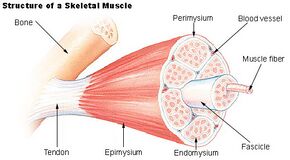Biology:Endomysium
| Endomysium | |
|---|---|
 Structure of a skeletal muscle. (Endomysium labeled at bottom center.) | |
| Anatomical terminology |
The endomysium, meaning within the muscle, is a wispy layer of areolar connective tissue that ensheaths each individual muscle fiber, or muscle cell.[1][2][3] It also contains capillaries and nerves. It overlies the muscle fiber's cell membrane: the sarcolemma. Endomysium is the deepest and smallest component of muscle connective tissue. This thin layer helps provide an appropriate chemical environment for the exchange of calcium, sodium, and potassium, which is essential for the excitation and subsequent contraction of a muscle fiber.
Endomysium combines with perimysium and epimysium to create the collagen fibers of tendons, providing the tissue connection between muscles and bones by indirect attachment.[4] It connects with perimysium using intermittent perimysial junction plates.[5]
Collagen is the major protein that composes connective tissues like endomysium.[6] Endomysium has been shown to contain mainly type I and type III collagen components, and type IV and type V in very minor amounts.[7] Others have found type IV and type V more common.[2]
The term cardiac skeleton is sometimes considered synonymous with endomysium in the heart, but cardiac skeleton also refers to the combination of the endomysium and perimysium.
Clinical significance
Anti-endomysial antibodies (EMA) are present in celiac disease.[8] They do not cause any direct symptoms to muscles, but detection of EMA is useful in the diagnosis of the disease.[9]
See also
- Connective tissue in skeletal muscle
- Epimysium
- Perimysium
References
- ↑ Abdulkarim, Ahmad S.; Murray, Joseph A. (2004-01-01), Johnson, Leonard R., ed. (in en), Celiac Disease, New York: Elsevier, pp. 278–283, doi:10.1016/b0-12-386860-2/00110-6, ISBN 978-0-12-386860-2, http://www.sciencedirect.com/science/article/pii/B0123868602001106, retrieved 2020-11-02
- ↑ 2.0 2.1 Stecco, Carla; Hammer, Warren; Vleeming, Andry; De Caro, Raffaele (2015-01-01), Stecco, Carla; Hammer, Warren; Vleeming, Andry et al., eds., "3 - Deep Fasciae" (in en), Functional Atlas of the Human Fascial System (Churchill Livingstone): pp. 51–102, doi:10.1016/b978-0-7020-4430-4.00003-8, ISBN 978-0-7020-4430-4, http://www.sciencedirect.com/science/article/pii/B9780702044304000038, retrieved 2020-11-02
- ↑ Laurent, Rodger (2010-01-01), Sambrook, Philip; Schrieber, Leslie; Taylor, Thomas et al., eds., "Disorders of Skeletal Muscle" (in en), The Musculoskeletal System (Second Edition) (Churchill Livingstone): pp. 109–122, doi:10.1016/b978-0-7020-3377-3.00008-1, ISBN 978-0-7020-3377-3, http://www.sciencedirect.com/science/article/pii/B9780702033773000081, retrieved 2020-11-02
- ↑ Saladin, K. S. (2012). Anatomy and Physiology: The Unity of Form and Function. New York, NY: McGraw-Hill.[page needed]
- ↑ Purslow, Peter P.; Delage, Jean-Paul (2012-01-01), Schleip, Robert; Findley, Thomas W.; Chaitow, Leon et al., eds., "1.1 - General anatomy of the muscle fasciae" (in en), Fascia: The Tensional Network of the Human Body (Oxford: Churchill Livingstone): pp. 5–10, doi:10.1016/b978-0-7020-3425-1.00035-0, ISBN 978-0-7020-3425-1, http://www.sciencedirect.com/science/article/pii/B9780702034251000350, retrieved 2020-11-02
- ↑ Christ, George J.; Passipieri, Juliana A.; Treasure, Trevor E.; Freeman, Phillip N.; Wong, Mark E.; Martin, Neil R. W.; Player, Darren; Lewis, Mark P. (2015-01-01), Vishwakarma, Ajaykumar; Sharpe, Paul; Shi, Songtao et al., eds., "Chapter 43 - Skeletal Muscle Tissue Engineering" (in en), Stem Cell Biology and Tissue Engineering in Dental Sciences (Boston: Academic Press): pp. 567–592, doi:10.1016/b978-0-12-397157-9.00047-3, ISBN 978-0-12-397157-9, http://www.sciencedirect.com/science/article/pii/B9780123971579000473, retrieved 2020-11-02
- ↑ Light, N; Champion, A. E. (1984). "Characterization of muscle epimysium, perimysium and endomysium collagens". The Biochemical Journal 219 (3): 1017–26. doi:10.1042/bj2191017. PMID 6743238.
- ↑ Keren, David F. (2013-01-01), Wild, David, ed., "Chapter 9.15 - Autoimmune Disease" (in en), The Immunoassay Handbook (Fourth Edition) (Oxford: Elsevier): pp. 869–890, doi:10.1016/b978-0-08-097037-0.00069-5, ISBN 978-0-08-097037-0, http://www.sciencedirect.com/science/article/pii/B9780080970370000695, retrieved 2020-11-02
- ↑ Pruessner, H. T. (1998). "Detecting celiac disease in your patients". American Family Physician 57 (5): 1023–34, 1039–41. PMID 9518950. http://www.aafp.org/link_out?pmid=9518950.
External links
- UIUC Histology Subject 777
- Illustration at wku.edu
- Anatomy photo: Musculoskeletal/muscle/skeletal1/skeletal3 - Comparative Organology at University of California, Davis
- MedEd at Loyola histo/practical/muscle/hp7-42.html
 |

